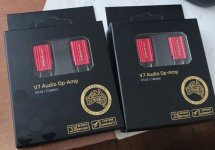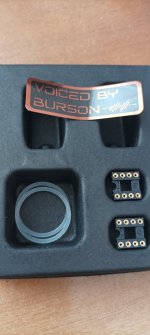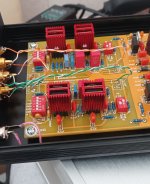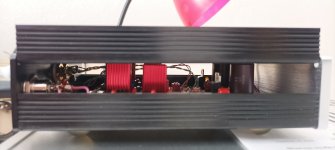Burson audio team sent me 4pcs of V7 vivid single opamps to test it in my phono preamp (i'm using t-phonum mk2 clone).
I have received them recently and tested only for few hours so maybe I'll extend this review in a while.
They come in cardboard packing, with additional extension sockets and rubber bands to hold it together with opamp. And a sticker, to make your device look more pricey )
My first concern was whether it will fit in my phono preamp casing, but luckily it fits perfectly )
How it sounds? Well that's a hard one for me because I'm comparing v7 with v5i (because I bought v5i to replace ne5534) and there is no such huge difference as it was between ne5534 and v5i.
First - the gain is a little lower than v5i and I guess that's the reason why v7 can be only applied in MM phono preamp.
Second - there is less noise in background, the difference is even bigger than the difference in gain but still they both have much lower noise level than the silent groove. Also with v5i I can hear some radio transmission (there is a cable radio line in the building), with v7 - not even a hint of it, but probably it is more gain related.
Third - V7 produce more heat than the v5, but it is just warm to the touch (casing is metal), so probably v7 consume more power.
And finally - it sounds more detailed to me, and a bit brighter in mids. So far in general it feels like low to zero feedback tube amp
I'm eager to test it in MC mode as soon as I get MC cartridge, maybe in combination with v5i to achieve acceptable gain.
I have received them recently and tested only for few hours so maybe I'll extend this review in a while.
They come in cardboard packing, with additional extension sockets and rubber bands to hold it together with opamp. And a sticker, to make your device look more pricey )
My first concern was whether it will fit in my phono preamp casing, but luckily it fits perfectly )
How it sounds? Well that's a hard one for me because I'm comparing v7 with v5i (because I bought v5i to replace ne5534) and there is no such huge difference as it was between ne5534 and v5i.
First - the gain is a little lower than v5i and I guess that's the reason why v7 can be only applied in MM phono preamp.
Second - there is less noise in background, the difference is even bigger than the difference in gain but still they both have much lower noise level than the silent groove. Also with v5i I can hear some radio transmission (there is a cable radio line in the building), with v7 - not even a hint of it, but probably it is more gain related.
Third - V7 produce more heat than the v5, but it is just warm to the touch (casing is metal), so probably v7 consume more power.
And finally - it sounds more detailed to me, and a bit brighter in mids. So far in general it feels like low to zero feedback tube amp
I'm eager to test it in MC mode as soon as I get MC cartridge, maybe in combination with v5i to achieve acceptable gain.
Attachments
Testing now with mc cart at33ptg/II and it works! Needed to crank up the volume knob a bit but it works and sounds amazing!
Actually after some comparison the v5i sound better in first stage of preamp with MC - more bass and highs are better (less harsh then with v7) and mids are more detailed, not on every record it is so noticeable, anyway now i understand why they not ment to work in mc stage. But v5i are so noisy compared to v7...
Last edited:
I took out the two NE5534s from my self-built Chinese amplifier ( https://www.ebay.de/itm/40323871287...IkhxjHJTLq&var=&widget_ver=artemis&media=COPY ) and replaced them with OP's from Ti ( NE5534A), no difference, when I then used the Burson Audio V7 vivid pro single the sound improved massively!

I was just sent a pair of Burson V7 Vivid opamps for review, so I'll add my review to this thread.
Burson V7V review
Unboxing:
The picture on the packet was misleading, the arrow marked “pin1” was pointing directly at pin 8, but was meant to be pointing to the shallow notch on the aluminium heatsink for correct orientation. I consulted the data sheet on the Burson site which showed the chip did indeed have the usual notch orientation. The writing on the case is the other side from the notch side. It was difficult to insert the opamp into a normal round pin socket, so I inserted it first into the supplied DIP8 round pin socket. This required some significant force before it clicked. The pins are evidently not quite the same pitch as the socket. The attached DIP8 socket then inserted smoothly into the DIP8 socket on the PCB. I didn’t want to use such force directly on the PCB.
Auditioning in the DAC I/V stage:
The DAC used was a Chinese PCM56 board to which were added AC power supplies and a suitable case. The PCM56 and opamp chips are socketed so can be replaced. This board came with 2 stages of NE5534, but performed better with just the first stage as I/V directly to the output. The NE5534s were replaced with a selection of opamps, the best of which were AD843, AD845 and AD797, which sounded good and fairly similar. With these opamps the sound of the DAC has been smooth, full and detailed with good tonality on acoustic instruments. Listening and review material was jazz piano trio, jazz small group vocals and opera excerpts. The critical factor in the auditioning was the tonality of acoustic instruments, how faithful they were to live instruments.
I auditioned the AD845 versus V7V with a fellow audiophile and our conclusions were the same.
Treble: The V7V had more detail and definition. The drumkit was cleaner and each element was more audible. Classical strings and woodwinds were more defined, and were smooth with no glare or brightness. The treble was altogether a step up in clarity, and where the difference was most noticeable.
Midrange: The mids were a little clearer with the V7V but less full and rich than the AD845. Overtones on grand piano were good. Voices were smaller but more defined than the AD845.
Bass: The bass on the V7V was clean and well defined, but again less full and weighty than the AD845.
Overall: The AD845 had more weight and fullness and this gave it a better balance. The V7V was a leaner sound top to bottom, but the treble stood out as more detailed. It would be a good choice for classical music, which was reproduced with excellent definition and tonality. For jazz the choice would be a fuller sound with the AD845, or more detail and definition with the V7V. The V7V would be a good choice for a warmer system with good extended bass. It undeniably has significant positive features which will appeal in the right system.
Burson V7V review
Unboxing:
The picture on the packet was misleading, the arrow marked “pin1” was pointing directly at pin 8, but was meant to be pointing to the shallow notch on the aluminium heatsink for correct orientation. I consulted the data sheet on the Burson site which showed the chip did indeed have the usual notch orientation. The writing on the case is the other side from the notch side. It was difficult to insert the opamp into a normal round pin socket, so I inserted it first into the supplied DIP8 round pin socket. This required some significant force before it clicked. The pins are evidently not quite the same pitch as the socket. The attached DIP8 socket then inserted smoothly into the DIP8 socket on the PCB. I didn’t want to use such force directly on the PCB.
Auditioning in the DAC I/V stage:
The DAC used was a Chinese PCM56 board to which were added AC power supplies and a suitable case. The PCM56 and opamp chips are socketed so can be replaced. This board came with 2 stages of NE5534, but performed better with just the first stage as I/V directly to the output. The NE5534s were replaced with a selection of opamps, the best of which were AD843, AD845 and AD797, which sounded good and fairly similar. With these opamps the sound of the DAC has been smooth, full and detailed with good tonality on acoustic instruments. Listening and review material was jazz piano trio, jazz small group vocals and opera excerpts. The critical factor in the auditioning was the tonality of acoustic instruments, how faithful they were to live instruments.
I auditioned the AD845 versus V7V with a fellow audiophile and our conclusions were the same.
Treble: The V7V had more detail and definition. The drumkit was cleaner and each element was more audible. Classical strings and woodwinds were more defined, and were smooth with no glare or brightness. The treble was altogether a step up in clarity, and where the difference was most noticeable.
Midrange: The mids were a little clearer with the V7V but less full and rich than the AD845. Overtones on grand piano were good. Voices were smaller but more defined than the AD845.
Bass: The bass on the V7V was clean and well defined, but again less full and weighty than the AD845.
Overall: The AD845 had more weight and fullness and this gave it a better balance. The V7V was a leaner sound top to bottom, but the treble stood out as more detailed. It would be a good choice for classical music, which was reproduced with excellent definition and tonality. For jazz the choice would be a fuller sound with the AD845, or more detail and definition with the V7V. The V7V would be a good choice for a warmer system with good extended bass. It undeniably has significant positive features which will appeal in the right system.
Now you might want to try the V7 Classic. I'm a Vivid user but supposedly the classic has a warmer sound.
- Home
- Design & Build
- Parts
- Burson v7 Vivid review



